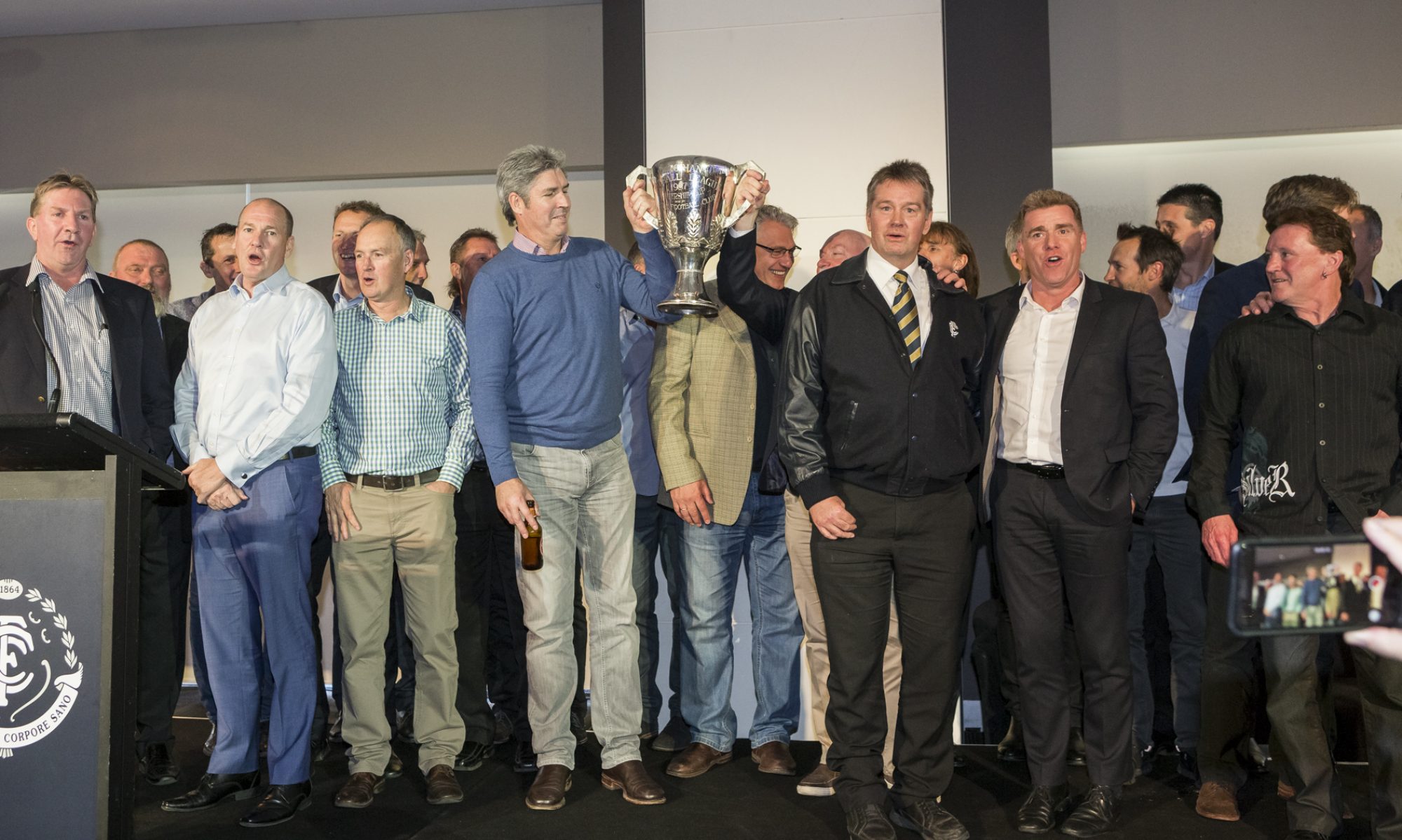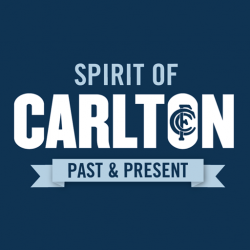By Tony De Bolfo
Betty Austin has seen fit to right the wrongs about her late father. In doing so she’s made available some terrific images and documents to perpetuate the memory of Alex Doyle, Carlton’s 53-game player through the Depression years.
For some time it’s been incorrectly reported that Alex embarked on a career as playing coach of Tasmanian football club Cananore on the completion of his playing career at Princes Park.
Not so says Betty. To Cananore’s chagrin, the deal fell through when Carlton refused Alex a clearance.
Instead, she says her father maintained a long-term involvement with the game in and around the Melbourne metropolitan area, as he committed his energies to his employer, the Fire Brigade.
The son of John and Elizabeth Doyle, Alex was one of three siblings born in the Victorian wheat district town of Murtoa on July 29, 1904. He was but an infant when his father was transferred to Yackandandah with the railways and later Horsham, where Alex plied his craft as a junior footballer.
Alex represented the Wimmera with great distinction on a number of occasions during football’s equivalent of cricket’s country week. In 1926, he took part in a kicking competition then sponsored by The Sporting Globe and convened by its football writer “Jumbo” Sharland. Alex thought he’d taken the chocolates with a drop kick measuring 72 yards five inches, only to be trumped by Echuca’s fabled Chinese footballer Les Kew-Ming with a 75-yarder.
By now, Alex’s feats were prompting intense interest amongst the inner city clubs Collingwood, Essendon, Hawthorn and of course, the good guys. The following handwritten letter, penned by the then Carlton Secretary and all-time great Carlton footballer Horrie Clover in December 1926, attests to this fact.
“Mr. Doyle,
Dear Sir,
Having heard many favorable reports of your outstanding ability on the football field I have much pleasure on behalf of the Carlton Club in extending to you a cordial invitation to join our Club for next football season.
Trusting that you will give this matter your earnest and favorable consideration and hoping that you will favor me with a reply at your earliest convenience.
I am, yours faithfully,
Horrie Clover
Secretary.”
For whatever reason, Alex opted to delay his introduction to VFL football and it wasn’t until late 1928 that he resolved to commit to Carlton, together with Horsham’s Frank Gill and Warracknabeal’s Charlie “Snowy” Parsons.
“Of course it was around about this time that everybody was looking for work and all these people had written to Dad not only to place him as a footballer but to offer him a job as well. This played a big part in Depression times,” Betty says.
The following letter to Alex, penned on a Carlton letterhead dated September 6, 1928, sets the scene at time when coin was still being cast about despite the dire economic circumstances.
“Dear Sir,
I am instructed by my committee to advise you that Messrs Crone and Clover reported that they interviewed you in Horsham during the week and were successful in inducing you to throw in your lot with us next season.
I can assure you that we are congratulating ourselves in securing your services and I am sure that you will not regret the step you have taken and we think a few men of your stamp will help us to be the premier league side for season 1929.
We have not broadcasted the fact that you have signed up with us, not even to our Committee, until the commencement of next season.
If you should be approached by other League clubs for your services next season be careful not to sign up with them because if you do you will disqualify yourself not only for playing with Carlton but also Melbourne football owing to the fact that you have signed up with more than one club. I would suggest if you are approached (and I am certain you will be especially if you play in Melbourne in Show Week) to tell those who approached you that you are going to Carlton next season.
I am looking forward with pleasure to meeting you in Melbourne at that time.
On behalf of my Committee I desire to thank you for signing up with us and I hope that your association with the Carlton Football Club will be a successful one as well as a profitable one.
Hoping that I shall have the pleasure of meeting you in the near future.
Yours faithfully,
PJ Cain
Secretary
PS. To keep yourself free from complications you will have to refuse any offers of money that might be made to you by other League Clubs.”
Alex took up lodgings as a boarder at No.52 Garton Street in the shadows of the Legends Stand. In time he would meet his future wife “Nellie” Lannge who lived with her family in the house next door.
.jpg)
He fronted for the first night of training under the watch of resident Senior coach and lifelong friend Dan Minogue at the Carlton ground at 4.45pm on the afternoon of Tuesday, March 12, 1929. So began what was to prove a brief but beautiful friendship for player and club which would take in 53 senior matches over three seasons through The Great Depression.
Wearing the No.19 now proudly sported by Eddie Betts, Alex pitted his skills against the likes of Melbourne’s Ivor Warne-Smith and St Kilda’s Colin Watson, the two greatest adversaries he ever confronted.
He won the hearts and minds of all Carltonians from bottom to top and a glorious certificate of appreciation, signed by President David Crone and Secretary Newton Chandler acknowledges the high regard in which Alex was held.
But luck would not run with the Carlton teams in which he featured, with both the 1929 and ’31 outfits falling six points agonizingly short of Richmond and Geelong in the respective preliminary finals of those years.
Remarkably, Alex also fronted up for Wednesday League games during the late 1920s early 30s. in those days, games comprised teams from the Air Force, Victoria Police, Yellow Cabs, Red and Checker Cabs, Post and Telegraph, Railways, the Victoria Market, Waterside Workers and of course, the fire brigade.
“The football was good and attracted quite a following as well as a lot of newspaper interest,” a brigade scribe later reported.
“To say the games were rugged and the boys were fractious is an understatement, so much so that with all the fights it was inevitable the competition had to fold up and fold up it did.
“The brigade were in the Wednesday League for years and withdrew for a number of reasons, mainly because the brawls and bad language had brought the competition into bad odour.”
By then, Alex’s future as a fireman was already assured. In January 1932, after accepting an invitation to contest a vacant employment position within the brigade, Alex won the role.
Thirty-five years later, he would receive a letter from the brigade carrying a seal of recognition for 35 years service.
Alex’s commitment to the MFB didn’t curtail his football involvement though. Rather, it enhanced it. In seasons 1933 and ’34, for example, he represented the then VFA club Preston whilst headquartered at the North Melbourne brigade and in 1935 he took up a position as Essendon’s reserve grade coach. A stint with the Oakleigh brigade came later, during which time Alex hooked up with the local football club as a selector.
Of course, Alex’s wife “Nellie”, son John and daughter Betty dutifully followed husband and father from station to station and as Betty said: “Wherever we moved with the fire brigade he got involved with footy”.
For years until his retirement, Alex maintained his passion for the great Australian game and for the old dark Navy Blues. Failing eyesight eventually put paid to his attendance at Carlton games and his final years were spent quietly at a home in East Doncaster.
After suffering a heart attack, Alex died in nearby Box Hill Hospital on January 21, 1973. He is buried in Springvale Cemetery with his beloved wife who survived him by some six years.
Today, Alex’s legacy lives on through Betty – a greater Carlton supporter there never was – together with his many grandchildren and great grandchildren, many of whom will be there come March 29 to cheer Chris Judd and the boys on.


